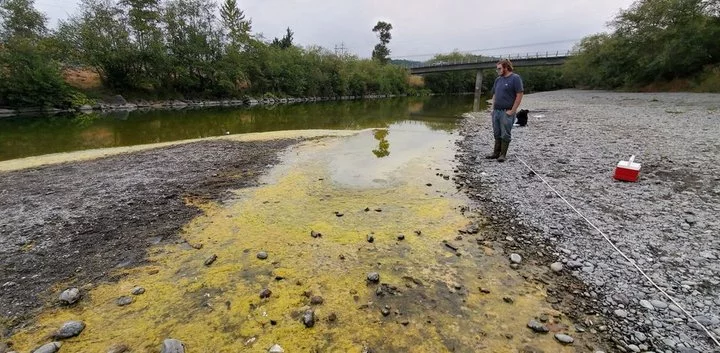Cyanobacteria on the Mad River in 2020. | File photo by Jacob Pounds, Blue Lake Rancheria.
Press release from the Humboldt County Department of Health and Human Services:
As we go into the long weekend, local Environmental and Public Health officials are reminding residents to keep an eye out for cyanobacteria while recreating at area rivers and lakes. This reminder comes after algal blooms were recently detected by North Coast Regional Water Quality Control Board staff in the South Fork of the Eel River at Richardson’s Grove, Cook’s Valley and in Miranda.
Cyanobacteria, also known as blue-green algae, can be present in any fresh water body, and looks like dark green, blue-green, black, orange or brown scum, foam or mats on the riverbed or floating on the water. Cyanobacteria can produce harmful compounds, such as toxins and taste and odor compounds, that cause health risks to humans and animals. Warm water and abundant nutrients can cause cyanobacteria to grow more rapidly than usual causing “blooms.” These blooms are termed “harmful algal blooms.”
In previous years, cyanobacteria has been confirmed in water bodies within Humboldt and surrounding counties, including the Mad River, South Fork Eel River, Van Duzen River, Trinity River, Big Lagoon, Stone Lagoon, Clear Lake and Lake Pillsbury. It is difficult to test and monitor the many lakes and miles of our local rivers. Most blooms in California contain harmless green algae, but it is important to stay safe and avoid contact.
While most cyanobacteria do not affect animals or people, some are capable of producing toxins that can be harmful to animals and humans. Dogs and children are most likely to be affected because of their smaller body size and tendency to stay in the water for longer periods of time.
Officials recommend the following guidelines for recreational users of freshwater areas:
- Keep children, pets and livestock from swimming in or drinking water containing algal scums or mats.
- Adults should also avoid wading and swimming in water containing algal blooms. Try not to swallow or inhale water spray in an algal bloom area.
- If no algal scums or mats are visible, you should still carefully watch young children and warn them not to swallow any water.
- Fish should be consumed only after removing the guts and liver and rinsing fillets in tap water.
- Never drink, cook with or wash dishes with water from rivers, streams or lakes.
- Get medical attention immediately if you think that you, your pet or livestock might have been poisoned by cyanobacteria toxins. Be sure to tell the doctor or veterinarian about possible contact with cyanobacteria or algal blooms.
- Join or support one of the many watershed and river organizations.
To learn more about cyanobacteria and harmful algal blooms, visit the state of California’s website at www.mywaterquality.ca.gov/habs/index.html.
To report a bloom, e-mail CyanoHAB.Reports@waterboards.ca.gov or call 844-729-6466 (toll free). Blooms can also be reported via the “bloomWatch” app which is available for free download on iTunes or Google play.
For information on conditions in Humboldt County, contact the Humboldt County Department of Health & Human Services, Division of Environmental Health at 707-445-6215 or 800-963-9241. Photos of suspected blooms can also be emailed to envhealth@co.humboldt.ca.us.

CLICK TO MANAGE